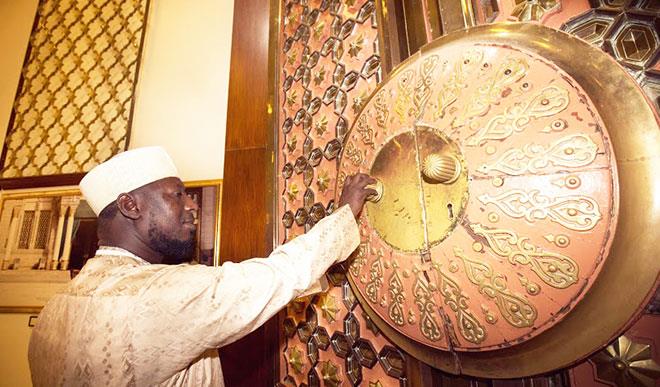A closer look at Ka’aba’s relics
The month was March. The year, 2016. The visitors were 250 Muslims from 10 African countries, including Nigeria, on umrah (lesser hajj) and visit to the two holy mosques in Mecca and Madina, a programme organized by the custodian of the two holy mosques, King Salman Bn Abdulaziz Al Saud. One of the exciting places […]


The month was March. The year, 2016. The visitors were 250 Muslims from 10 African countries, including Nigeria, on umrah (lesser hajj) and visit to the two holy mosques in Mecca and Madina, a programme organized by the custodian of the two holy mosques, King Salman Bn Abdulaziz Al Saud.
One of the exciting places visited in Mecca was the museum for the Two Holy Mosques.
This beautiful edifice contains cultural and historical artefacts and relics from the Grand Mosque in Mecca and the Prophet’s mosque in Madina, the two most sacred places in the Muslim world.
The museum contains many objects, ranging from coins, vessels and jars to building materials, some as old as 1000 years.

The museum contains photos of old and new models of the two holy mosques.
There is a section (room) dedicated to precious artefacts and writings.
The Ka’aba hall contains model of the kiswa (ka’aba cloth), old doors used in the ka’aba and the machines used in weaving the kiswa, among others. The cloth, which is changed once every year, has a dedicated factory for its manufacture and cost the Saudi government SR25 million (N1.3 billion).
The photography section includes rare pictures of the Two Holy Mosques, most of them old. But you also see photos of the new look of the Two Holy Mosques drawing a huge contrast from what they looked many centuries ago and now.

Visitors have conversation over the copy of the Quran compiled during the reign of Callph Uthman Bin Afffan at the Museum
Also, in a hall dedicated to manuscripts were models of calligraphy in the Two Holy Mosques, and a copy of the Quran written by Uthman bin Affan (third khalif after the prophet’s death).
The glorious Quran, the last testament by God to humankind through Prophet Muhammad, was revealed during a period of 23 years. Many of the prophet’s companions had the revelations in memory, which were written in parchments. The writings were put together during the reign of Khalif Uthman (632-634 C.E.)
At the Mecca museum is found a copy of the Uthmanic copy of the Quran in its form.
Another interesting relic at the Mecca museum for the Two Holy Mosques is the framework of the well of Zamzam. The Zamzam well historically dates back to the thousands of years when prophet Ibrahim arrived at the location of Ka’aba in today’s Mecca with his wife and his son, Ismaeel, following the instruction of God.
Ibrahim left his wife and little son behind but before his return, hunger and thirst had struck mother and son. Ismaeel cried endlessly apparently for water and his helpless mother ran fruitlessly from one end of the Safa to Marwa seven times, but there was no sign of water in sight – in a desert.
In one of the shuttles back to where Ismaeel was, she found water gushing out of his feet. She quickly helped herself for Ismaeel. The well has never dried up afterward and since then, millions of pilgrims from all corners of the world come to worship at the mosque and fetch from it.
In modern times, the well, which is famous for its healing and cleansing power, is now connected to taps within and around the grand mosque for easy access to pilgrims.
Some related relics on display are jars and water skin used in fetching water from the well, as well as coins found from the well during cleaning and maintenance work dating back to more than a thousand years. The water skin, a brass urn which used to be in the well of Zamzam, dates back to more than 1300 years ago.
Another relic of the Zamzam well at the museum is a brass bucket, which was in use as far back as 1299.
The general framework of Zamzam well prepared in the early 14th century and old inscriptions and photographs of the old and new well of Zamzam are in display in their full splendour.

Also on display are some rare photographs of the prophet’s mosque in its old self, among other artefacts.
Old architectural pieces of the Mecca grand mosque at the museum include a replica of the station of Ibrahim, the doors of the mosque, old locks, cover clothe of the Ka’aba, and a wooden pillar of the Ka’aba dating back to the time of the prophet. The wooden pillar has now reduced to stump after more than 1400 years.

The writer at the Museum
One of the pillars of the holy Ka’aba, with its wooden base and crown, dates back to the construction of Abdallah Ibn Zubair in 65 after hijrah (55 years after the prophet’s death).
The hijrah date marks the migration of the prophet from Mecca to Madina in 622 C.E.
There is also the old lock and key of the holy Ka’aba dating back to 1309 after the hijrah and during the reign of Ottoman Sultan Abdulhamid, just as you have a staircase of the ka’aba dating back to 1240 after hijrah.
